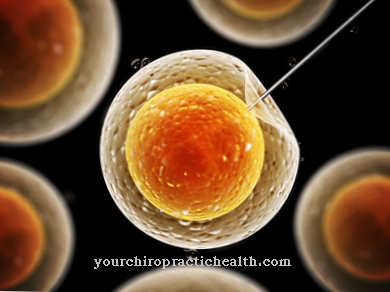The Angiography is a radiological procedure to visualize the vessels of the human organism. As part of an angiographic examination, the venous and arterial blood vessels as well as the lymphatic vessels can be visualized with the aid of X-rays, magnetic resonance or computer tomography.
What is angiography

As Angiography is a minimally invasive imaging method for displaying human vessels and their changes (including constrictions) using catheters and / or contrast media.
As standard, angiography is carried out as a so-called digital subtraction angiography. In addition, CT angiography, magnetic resonance angiography or indocyanine angiography for imaging the fundus are available.
The venous and arterial blood vessels (phlebography), lymph vessels (lymphography), coronary arteries (coronary angiography), varicose veins (varicography) and vascular prostheses can be visualized as part of the various angiographic examination methods.
Function, effect & goals
The conventional Angiography an X-ray tube with an image intensifier, usually attached in a C-arm arrangement. During the angiography, the C-arm is guided on or around the patient in order to ensure that the vessels can be viewed from different perspectives.
Before the examination, the person concerned is given a local anesthetic so that a puncture needle can then be inserted painlessly into the artery or vein to be examined. First, a flexible, narrow guide wire with a soft tip is inserted through the puncture needle, and a catheter is then placed at the point to be examined in the vessel with the help of the wire. A contrast medium injected through the catheter is used to visualize and assess the blood vessel.
During the injection of the contrast agent, electronic recordings of the region to be assessed are made with the X-ray tube at short intervals, which are then processed with the computer so that only the blood vessels of interest are displayed (digital subtraction angiography). In contrast, in CT angiography, the contrast agent is not injected directly into the vascular area to be examined, but into the arm vein.

MR angiography provides three-dimensional images and can be performed with or without a contrast medium. One advantage over conventional radiographic vascular imaging is that it does not require a catheter. Angiography is an important instrument for confirming the diagnosis of vascular diseases. Angiography is used for changes in arterial vessels such as arteriosclerosis and their secondary diseases (stenoses, peripheral arterial occlusive disease), for acute occlusions (including myocardial infarction), aneurysms (vascular sacs), malformations and injuries to vessels.
Thromboses and varicose veins are typical changes in the venous vessels and can also be shown angiographically. In addition, angiography can be carried out in advance of surgical interventions in the case of peripheral vascular occlusive diseases, especially if the walking distance is severely restricted (less than 200 meters), if there is a pronounced narrowing of the vessels supplying the brain or to map the vessels of the organ to be operated on (including the liver).
In addition, angiography can be used to exclude or detect renal artery stenosis (narrowing of the renal artery) in uncontrollable hypertension (high blood pressure).
Risks & dangers
There one Angiography is a minimally invasive procedure, no complications are to be expected if it is carried out correctly. After the examination, a bruise may appear at the puncture site in rare cases.
Impairments to the vessel walls (including aneurysm) also occur very rarely. In the case of pronounced changes and / or calcifications in combination with stenoses, blood clots or occlusions and injuries to the vessels by the catheter or guide wire can be observed extremely rarely. In addition, if sensitivity to iodine has not been determined in advance as a reaction to the contrast medium, sneezing, pruritus (itching), skin rash or nausea and, in the worst case, severe reactions of the cardiovascular system (anaphylactic shock) may occur.
Furthermore, angiography should not be used if there is hemorrhagic diathesis (increased bleeding tendency) or generalized inflammation (including sepsis). While angiography with iodine-containing contrast media is contraindicated in cases of pronounced hypersensitivity because of the increased risk of anaphylactic shock, medication can be used to counteract a mild contrast medium reaction in order to ensure angiography free of side effects.
If the thyroid gland malfunctions, it is advisable to check the metabolic status of the organ prior to the angiographic examination in order to avoid derailment. If there is a functional disorder of the kidneys with increased creatinine levels, alternative examination methods such as Doppler sonography or magnetic resonance imaging should be weighed against angiography to reduce the risk of additional functional impairments (contrast medium nephropathy).













.jpg)

.jpg)
.jpg)











.jpg)